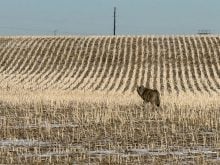David Kolsrud is a third-generation Beaver Creek, Minnesota farmer who
wants to preserve farming as a way of life.
Speaking in Saskatoon at a Saskatchewan Agrivision conference on
ethanol Jan. 30, Kolsrud detailed how a threat to farm life in the
1980s forced his community to get politically active and seek out
alternatives for their farm products. They decided to turn their corn
into energy.
Farmers launched a 200-member new generation co-op in ethanol
production called Corn-er Stone, managed by Kolsrud.
Read Also

Agritechnica Day 2: The future of tractor power, building quicker crop apps and large farms and tech
Agritechnica Day 2: The future of tractor power, building quicker crop apps with Syngenta and large farms and tech
The mission was to create income for owners by adding value to
agricultural products raised in the region.
The co-op committed cash and commodity to the new ethanol plant.
They were helped by tax incentives, environmental legislation and loan
guarantees from the United States Department of Agriculture.
The Minnesota Ethanol Program requires the state-wide use of ethanol
blended fuel, also known as oxygenated fuel.
A 20-cent per gallon ethanol producer incentive provides payment for
fuel produced.
Currently, 160 million bushels of corn, or approximately 20 percent of
the state’s corn crop, is made into ethanol and related products.
Minnesota’s 14 ethanol plants produce more than 300 million gallons of
ethanol each year.
“The government gave us the tools to work with,” Kolsrud said.
“It was a kind of subsidy or investment.”
In his home county of 6,000 residents, Kolsrud estimated there is now
an additional $12 million circulating in the economy as a result of the
plant.
“It has made a difference,” he said, citing numerous “side streams”
generated by ethanol production.
“These people don’t complain but look at the next thing they can do.”
In addition to fuel ethanol, corn plants produce protein livestock feed
plus products like starch, sweeteners and carbon dioxide.
Kolsrud said government financial support and legislation was central
to moving ahead with the ethanol industry.
In Canada, the federal government hopes to launch five to six new
ethanol plants, or increase current production four-fold to produce one
billion litres by the end of the decade.
Margaret Bailey, of Natural Resources Canada’s fuels policy and
programs, said the government will release a report and discussion
paper on alternative energy sources in the spring.
She co-manages Future Fuels, which is examining the use of ethanol in
transportation fuels.
The government is concerned about climate change and wants to reduce
emissions and revitalize rural communities, she said.
She suggested Saskatchewan can also support the launch of an enhanced
ethanol industry and the creation of new markets for grain crops by
creating less restrictive tax practices.
Saskatchewan has two ethanol plants located at Kerrobert and Lanigan.
Minnesota state representative Bob Ness said agriculture is in an
accelerated state of transition and ethanol is a part of that future.
“Value-added agriculture is about empowering farmer-producers to be
full partners in agriculture,” he said.
He called the American ethanol industry a success story and predicted
demand will continue to grow as the country seeks to reduce emissions
and its reliance on foreign fuels.














